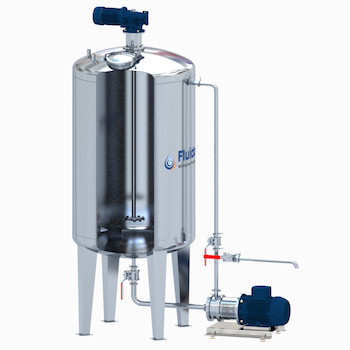-
Pre-Mixing and Wetting:
-
High-Speed Disperser:
- Application: The high-speed disperser is used initially to pre-mix pigments, binders, and other solid components in a liquid phase.
- Function: The disperser's high rotational speed creates a strong vortex, effectively wetting and breaking down agglomerates in the pigments, ensuring they are evenly dispersed in the liquid.
-
Particle Size Reduction and Dispersion:
-
High-Speed Disperser:
- Application: Continued use of the high-speed disperser aids in further particle size reduction and complete dispersion of solid components.
- Function: The disperser's high shear forces break down pigment agglomerates and promote a fine and uniform particle distribution in the ink.
-
Inline Homogenization:
-
Inline Homogenizer:
- Application: After pre-mixing and dispersion with the high-speed disperser, the ink passes through an inline homogenizer.
- Function: The homogenizer refines the particle size distribution, ensuring a more uniform and stable dispersion of pigments and other components. It enhances the ink's color intensity and provides a smooth finish.
-
Emulsification of Binders and Additives:
-
Inline Homogenizer:
- Application: The inline homogenizer is employed to emulsify and blend binders and additives into the ink formulation.
- Function: By applying high pressure and shear, the homogenizer creates a fine emulsion, ensuring the effective incorporation of binders and additives for improved ink properties.
-
Stabilization of Emulsions:
-
Inline Homogenizer:
- Application: The homogenizer contributes to the stabilization of emulsions formed during the ink manufacturing process.
- Function: It prevents phase separation and coalescence, maintaining the stability of the ink formulation over time.
-
Color Matching and Consistency:
-
High-Speed Disperser and Inline Homogenizer:
- Application: Both devices play a role in achieving color consistency and matching throughout the ink batch.
- Function: The high-speed disperser initially breaks down pigment agglomerates for color development, while the inline homogenizer ensures uniform dispersion, contributing to consistent ink color from batch to batch.
-
Fine-Tuning of Viscosity and Rheology:
-
Inline Homogenizer:
- Application: The homogenizer is used for precise control of ink viscosity and rheology.
- Function: By refining particle size and distribution, the homogenizer helps achieve the desired ink viscosity, improving flow properties and printability.
-
Final Quality Checks:
-
Quality Control:
- Application: Throughout the process, quality checks are conducted to ensure the ink meets desired specifications.
- Function: High-speed dispersers and inline homogenizers contribute to the creation of inks with consistent properties, meeting quality standards for color, stability, and performance.
-
Cleaning-In-Place (CIP) Process:
-
Maintenance:
- Application: After the manufacturing process, CIP systems are employed for cleaning.
- Function: Ensures thorough cleaning of the equipment, including the high-speed disperser and inline homogenizer, preparing them for subsequent batches and preventing cross-contamination.
The combination of a high-speed disperser and an inline homogenizer in ink manufacturing optimizes the dispersion of pigments, improves color consistency, and enhances the overall quality and performance of the ink formulation. This integrated approach ensures that the ink meets the stringent requirements of various printing applications.
